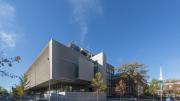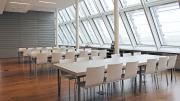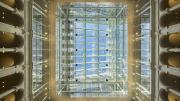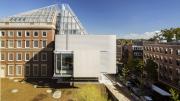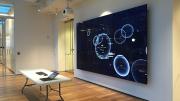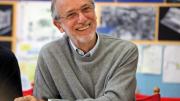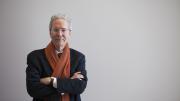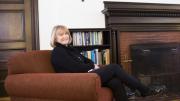In the flurry of special talks, community celebrations, and previews building up to the Harvard Art Museums’ official reopening on November 16, commentators have expressed the new building’s unity of form and function through an abundance of metaphors. Cabot director of the Harvard Art Museums Thomas W. Lentz has often said that he did not want the collections to feel like a “static treasure house” or an “academic bunker.” Instead, he says, the expanded and renovated museums form a “teaching machine.”
The Calderwood Courtyard, on the museum’s ground floor, forms the heart of the new building: from that piazza-like space, a visitor can easily observe how the rest of the machine functions, and what makes it tick. This central, public space unites the Fogg, the Busch-Reisinger, and the Sackler museums. It also has two sets of doors—one at the original 32 Quincy Street address, Lentz points out, and another on the opposite side, on Prescott Street—inviting further comparisons. He encourages people to think of the building as a route in itself. Because it allows the public to pass through without having to gain formal admission to the museums, he says, the ground floor can function as “another street” as well as a “rendezvous point.” From this piazza, it’s possible to gaze upward and into the upper floors of gallery and conservation spaces, capped by the glass roof that Piano has repeatedly called a “lantern.” The structure appears to “lighten and lighten and lighten,” he says, “until the top, where it’s just light.”
Describing how the Fogg Art Museum, the Sackler Museum, and the Busch-Reisinger Museum were made to physically connect with one another, Lentz declares that the new building creates “apertures in all directions” on the second and third floors. Thematically and physically, one collection opens into the next, staging unlikely conversations through adventurous curation. On the third floor, sculpted heads from Benin, Rome, and northern India sit side-by-side. Pieces from Lorraine O’Grady’s Miscegenated Family Album, in which the artist juxtaposes family portraits with ancient Egyptian imagery, hang in the same room as rare fragments of tapestry and ancient artifacts.
With channels open among the three collections, artworks formerly held separately have begun to mingle and intermix (though they are scrupulously labeled by holding collection). Though Lentz emphasizes that the individual characters of the three museums remain intact, “We see a lot of migration of objects, and I expect that will increase over time.”
The third floor is also home to special exhibitions, including the inaugural presentation of Rothko’s restored Harvard Murals, as well as an exhibit titled Rebecca Horn: Work in Progress, displaying filmed performances, sculptures, and photographs by the contemporary German artist. “It all interlocks,” the artist herself has said—not least with the installation commissioned specifically for the lower levels of the new building. When activated last Wednesday, a machine sprayed black onto the white wall, and onto three opening and closing books by Pessoa, Kafka, and Joyce. Horn calls Flying Books under Black Rain Painting a kind of “baptism” for the new institution. The installation links the ground floor to the lower lobby, where the new Menschel Hall will show her full-length feature films.
This auditorium includes the most sophisticated projection system on campus, Lentz says, as well as surround sound: “I watched about 10 minutes of Jurassic Park in here, and it about blew me out of my seat.” With 300 seats, all of them with iPads embedded in the retractable armrests, the space will also serve as a lecture hall: “Imagine generations of Harvard students falling asleep comfortably here.”
The fourth floor was also designed with students in mind. Mark Carroll, an architect at the Renzo Piano Building Workshop, says that the Art Study Center was “a hot topic” during the building’s design process. (“The other was the loading dock, of course,” Carroll joked.) How could they make it easy for pieces to be requested, and transported to the center, while also maintaining security? Charles Klee, principal at the Boston-based design firm, Payette, which partnered with Piano’s workshop, adds that there had been an additional challenge in designing this space for the public: “how to make them understand” that this is a space where they are welcome.
The fifth level houses the “lightbox gallery,” with screens that allow visitors to interact with the collections digitally, as well as the renowned conservation labs. “It’s no accident that the Straus Center is at the top and center of our building,” says Lentz. “It used to be a cloistered world” in the labs, he said, but the new layout brings together curation and conservation, making both visually accessible to visitors. After wending their way through the floors of galleries, art lovers can take in the sight of conservators and scientists at work. “People can intuitively understand what we do up here.”
Ten days before the official November 16 opening, attendees packed the Graduate School of Design’s Piper Auditorium and spilled into Gund Hall’s overflow spaces to hear the architect answer the title of his lecture: “How Did You Do It, Mr. Piano?” Wearing a t-shirt emblazoned with the words, “Trust me, I’m an architect,” in magenta, Piano first said, “I wasn’t alone.” In a project 17 years in the making, he added, “You don’t keep count of who got the idea. It’s important to share.” He lingered upon a favorite detail: alcoves in the museum left relatively empty, their main feature the large windows that face out and onto the world. The museum staff had to be talked into it, Piano explains, but he convinced them that “a museum is a place where you need rest—not just for your legs, but for your mind.”
Saying he wanted to keep his evening talk short, the architect ended with a sentiment that explained the Harvard Art Museums most grandly, and most simply: “This building, this institution, is fundamentally about beauty. And I'm convinced, as many people are convinced, that beauty will save the world. Not all together—one by one. But it will save the world.”
The following morning, wearing a blazer for the press preview, Piano introduced his own work of art this way: “There’s very little an architect should say at the opening of a building—just ‘Welcome!’”
